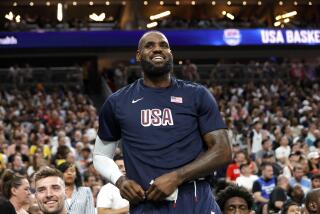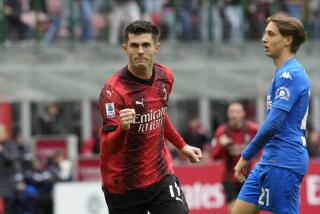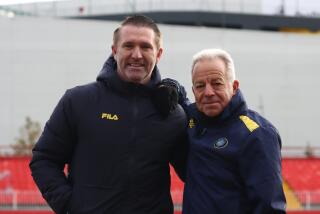They’re Pumping Up Basketball in Europe : It’s Not Yet as Popular as Soccer, but America’s Game Is Booming
- Share via
LAUSANNE, Switzerland — European basketball is not the National Basketball Assn. by a long shot. That was clear from the moment Milan’s Tracer team and Tel Aviv’s Maccabi arrived a couple of weeks ago in this quaint city overlooking Lake Geneva for their Cup of Champions final.
Instead of a real basketball court for probably the most important event of the thriving European basketball season, the teams had to play and practice on floorboards laid out in the teeth-chatteringly frigid Malley Ice Paladium, a giant arena built for the European figure skating championships that are regularly held here.
“I knew before we came here that things were going to be bad,” said Tracer Coach Dan Peterson, an animated, 5-foot-5 American who has been at the forefront of Italian and European basketball for a decade. “But this is unbelievable: This is an ice rink, not a basketball court.”
His team is powered by two U.S. stars in three-time NBA scoring champion Bob McAdoo and Ken Barlow, the Atlanta Hawks’ 1986 first-round draft choice from Notre Dame. As the players went out onto the temporarily laid board floor to begin their final workout, Peterson began complaining to organizers about the lack of warmth coming from half a dozen industrial air blowers set up along the court edges and at the rough, unvarnished nature of the floor he said would tear his players legs “to pieces.”
“No, this isn’t the NBA,” said Peterson, 51, shaking his head and jamming his hands into the pockets of his tightly zipped quilted ski parka, “but it is still fun and it is good basketball.”
How much fun and how good was demonstrated here when his Milan team beat the pride of Israel (which, along with Turkey is included in the European league) for the Champions Cup, 71-69, in a game decided in the last second by the failure of a final Maccabi shot from outside that rolled along the rim--and out.
That the final in the 10,000-spectator arena was sold out, and thousands of other fans from Italy and Israel who flocked here were forced to watch on television, demonstrated how European basketball is coming of age. After years of struggling in the provinces and competing unfavorably with soccer, it has begun to develop a real audience.
It wasn’t always so, of course. Basketball is a foreign transplant in Europe, having pretty much been introduced here by U.S. soldiers in the wake of World War II. It lingered in the boondocks of European sports until only recently when it has begun to catch on, especially in Italy, Spain, France and Israel.
To understand the overwhelming U.S. influence on the sport in Europe one had only to look at the Tracer-Maccabi final. The winning team not only had a U.S. coach, McAdoo and Barlow, but another American, now with a dual Italian citizenship, Mike D’Antoni, a former NBA player from Marshall University who has played in Italy for 10 years.
Maccabi was led by American players Lee Johnson of East Texas State and Kevin Magee out of the University of California Irvine.
The European Basketball Assn. now limits teams to two Americans, a rule provoked six years ago when league teams began to recruit as many U.S. players as they could, especially when they were of local national parentage and quick local citizenships could be arranged for them to bend the rules.
D’Antoni, 36, the Tracer captain, is a case in point. When he came to Italy as one of the regulation token U.S. players, sports authorities told him after he had played here four years they could get him Italian citizenship because his grandfather had been an Italian migrant to the United States. He agreed, because that would allow another U.S. player to join the team.
Nowhere were such dodges used more successfully than in Israel, according to Israeli sports authorities here. American players were recruited in droves a decade ago because they could have dual citizenship on the basis of the law of the return. Reform rabbis converted a substantial number of black American players so they could play in the Israeli leagues as Israeli citizens.
Except for some Eastern bloc countries such as Yugoslavia, a basketball powerhouse in its own right, there are American players in most of the 30 nations in the league.
In the past 18 years, Richard Kaner, the New York-based director of the European Basketball Association (and an international consultant for the Atlanta Hawks), has placed about 500 U.S. players on European teams, where they are paid anything from the $300 a month a little-known import might get on a low-level Danish club to the $300,000 a season Tracer is reportedly paying McAdoo, now 35.
McAdoo, just two years since he was part of the 1985 NBA champion Los Angeles Lakers, earned his pay by helping lead Milan’s squad to the Cup of Champions final victory--with a noble assist from Barlow, D’Antoni and Dino Menghini, the aging center who remains the greatest native player in Italy.
Peterson coached the University of Delaware varsities of 1965-70 before going off to Chile under the aegis of the Peace Corps to coach the Chilean national team. He maintains that, of all the countries in the European League, Italy is probably way ahead of the field with the best native players and, with American imports, probably somewhere between the best NCAA teams and the lower-echelon NBA teams.
“The game is getting better here every year,” said Peterson, who lives in Chattanooga, Tenn., with his family in the offseason. “I think the top four or five teams in our Italian league are above the best in the NCAA championships because they are older and more experienced, and would probably hold their own with the bottom seven NBA teams.”
What inspires an American player to throw in with the Europeans? A combination of personal adventure, opportunity, education and desperation.
McAdoo, for example, was on the downside of his career in the NBA and probably would have had a hard time making any team this season. He says he came over when the Philadelphia 76ers, the last of his seven NBA teams, “dragged their heels” last year over renewing his contract. “They were trying to hold out so they could pick me up in November or December. But I wanted to play in September, so when I got an offer from Milan, I took it.”
Barlow joined Tracer for different reasons. After the Hawks drafted him No. 1, they failed to reach contract agreement.
“I had an option to come here and play right away, which I might not have been able to do in Atlanta,” Barlow said. “So I came here because it helped my game and will probably make me more valuable a player when I get back to the NBA next season.”
Others gravitate to Europe because they can’t make an NBA roster and still want to play.
Next fall, for the first time, Milan Tracer is a prospective invitee to an open tournament in Milwaukee involving the NBA Bucks.
“Our time is coming,” Peterson says. “Every year our teams are better and stronger and the popularity of the game in Europe is stronger. It may never rival soccer, but we are definitely moving to be the second sport in Europe.”
More to Read
Go beyond the scoreboard
Get the latest on L.A.'s teams in the daily Sports Report newsletter.
You may occasionally receive promotional content from the Los Angeles Times.










